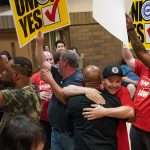SAN FRANCISCO — One was a “teddy bear and an amazing man,” according to his wife. Another overcame methamphetamine and heroin addiction in favor of family life. The five men had overcome childhoods that were tumultuous, but they’d found stability in their 30s and early 40s.
There was just one problem: They’d not only joined the same San Francisco-based gang, but between 11 and 18 years ago, they’d all committed at least one murder, gotten away with it, and simply moved on with their lives.
Then federal and state authorities started sniffing around, and everything changed. Now, co defendants Jonathan Aguilar, Eddy Urbina, Orlando Hernandez, Weston Venegas, and Juan Carlos Gallardo will be spending the next 20-30 years in prison. For most, it means no chance for freedom until their 50s and 60s.
Their sentences were a major step towards resolving a large-scale racketeering case aimed at the 19th/16th Street Sureños, a San Francisco-based gang that prosecutors have linked to seven killings and numerous other violent crimes. The murders included the killings of teens, innocent bystanders, and two double-homicides, all directly linked to gang business in one way or another.
The group was indicted in 2018. Defense attorneys have suggested in court papers that these seven cold case homicides were solved because at least one informant came forward, and that it was related to another, unnamed gang prosecution involving Sureños in the Bay Area.
Before they were sentenced, all five men had a chance to lay out their biographies in publicly filed court papers. They told similar stories of poverty, violence, murder, and regret.
One of the men, Aguilar, immigrated with his family from El Salvador when he was a child, after witnessing bombing and guerilla warfare during a civil war that claimed an estimated 75,000 lives. He landed between two rival gang territories in San Francisco; one day Sureños surrounded him after school, jumped him for being friends with a Norteño member, then offered him a chance at joining their gang, his attorney wrote in court papers.
“He spent his first five years living in a war zone and grew up in poverty,” the attorney, Matthew Dirkes, wrote in a sentencing memo. “He escaped the violence of El Salvador only to land in the middle of gang warfare in the Mission District.”
By 17, Aguilar was a high school dropout and heroin dealer. In 2006, at age 20, he and another man shot and killed Russell Lee Cummins, 26, and a second person whose name has not been publicly released, and attempted to kill two others, all because one of the four victims had “defied the will” of the gang, prosecutors said in court papers. In 2008, Aguilar himself was shot and partially paralyzed, then subsequently distanced himself from gang life, his attorney wrote.
Aguilar was given 30 years.
Urbina, who pleaded guilty to a federal offense in the double homicide of 19-year-old Noel Espinoza and 23-year-old Matthew Solomon, was also 20 at the time. When he participated in the double killing he was “in the throes of grief” over a friend who’d been killed hours earlier, his lawyers said in court papers. Urbina started using methamphetamine and heroin at a young age but got sober in 2016 after picking up a federal gun case, the defense attorneys added.
“What I learned about myself: My head is not ready to leave gangs but my heart does want to,” Urbina wrote, according to a defense sentencing memo, adding that he wants to “start making decisions from the heart and attempt to get out of head.”
Urbina received a 32-year sentence, the most of any of the five.
Two others, Orlando Hernandez and Weston Venegas, both received 25 years for the killing of 19-year-old Jacob Valdiviezo, a college football player who was the victim of a mistaken-identity killing. Prosecutors said Hernandez organized “the hunt” to kill a Norteño as vengeance over the murder of a Sureño known as “Trigger” in 2011. Venegas’ wife called him a “big teddy bear and amazing man” and urged the courts to “see the good in him.”
Gallardo — the son of a maintenance man who slept on the floor as a child because his family couldn’t afford enough mattresses for him and all his siblings — wept on the phone when he told his brother about his charges. In 2009, Gallardo shot and killed 16-year-old Salvador Cortez at a house party on Ohio Street in Richmond.
Prosecutors say he and other gang members arrived there simply to socialize, and that Gallardo killed Cortez after identifying him as a possible rival gang member. He received a 22-year prison sentence.
“Gallardo murdered (Cortez) practically on a whim; the death was at once senseless and entirely typical of the pattern of violence in which the enterprise has been engaged for decades,” prosecutors wrote, later adding that Gallardo’s more recent history “suggests he no longer poses the same danger he once did.”
Another co-defendant, Mario Reyes, received an 11-year federal prison term for pleading guilty to gang charges. A seventh co-defendant, Luis Cid-Salinas, was sentenced to time already served; details about why have been kept under seal, according to court records.
There are still active charges against Luis Rojas and Michael Rebolledo, who are charged with two and three murders, respectively, court records show.


